Home | Category: New Kingdom (King Tut, Ramses, Hatshepsut)
AKHENATEN AND MONOTHEISM
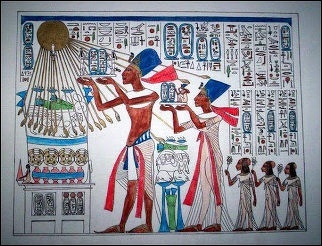
Akhenaten worshipping Aten
Known as the "great heretic," Akhenaten and his wife Nefertiti attempted to introduce the idea of monotheism to ancient Egypt. Akhenaten's single god was the Egyptian sun god Aten. Akhenaten named himself after the god (Akhenaten means “one who serves Aten”) and got rid of Atem, who had been the state god until then. Aten was described as the"embodiment of the mystical force of the sun."
Akhenaten was an uncompromising monotheist. Historian Cyril Aldred has speculated that monotheism was Akhenaten's own idea, the result of regarding Aten as a self-created heavenly king whose son, the pharaoh, was also unique. Akhenaten made Aten the supreme state god, symbolized as a rayed disk with each sunbeam ending in a ministering hand. Other gods were abolished, their images smashed, their names excised, their temples abandoned, and their revenues impounded. The plural word for god was suppressed. Sometime in the fifth or sixth year of his reign, Akhenaten moved his capital to a new city called Akhetaten (present-day Tall al Amarinah, also seen as Tell al Amarna). At that time, the pharaoh, previously known as Amenhotep IV, adopted the name Akhenaten. His wife, Queen Nefertiti, shared his beliefs. [Source: Helen Chapin Metz, ed. Egypt: A Country Study, Library of Congress, 1990]
To honor his god Akhenaten commissioned temples without roofs that were open to the sun and inscriptions that showed Akhenaten and his family being touched by sun’s rays. Akhenaten may have written a poem that went: "Beautifully you appear from the horizon of heaven...Oh living Aten, who initiates life...Oh sole god, without another beside him! You create the Earth according to your wish...You are in my heart, and there is none who knows you except your son."
In Akhenaten’s time the clergy was quite powerful. Akhenaten may have adopted monotheism partly as a means of displacing the powerful pagan clergy whose primarily god was Amun. Images of Amun, a major god, were smashed and his temples were closed. Soldiers were ordered to deface images of Amun and other gods. Egyptians were encouraged to believe that the sun god came to Earth in the form of the royal family.
RELATED ARTICLES:
AKHENATEN (1353 B.C. TO 1336 B.C.): HIS LIFE AND MYSTERIES SURROUNDING HIS FAMILY AND DEATH africame.factsanddetails.com ;
AKHENATEN AND AMARNA africame.factsanddetails.com ;
NEFERTITI: HER LIFE, BEAUTY, BUST AND MARRIAGE TO AKHENATEN africame.factsanddetails.com ;
AKHENATEN'S REIGN (1353 B.C. TO 1336 B.C.) africame.factsanddetails.com
Websites on Ancient Egypt: UCLA Encyclopedia of Egyptology, escholarship.org ; Internet Ancient History Sourcebook: Egypt sourcebooks.fordham.edu ; Discovering Egypt discoveringegypt.com; BBC History: Egyptians bbc.co.uk/history/ancient/egyptians ; Ancient History Encyclopedia on Egypt ancient.eu/egypt; Digital Egypt for Universities. Scholarly treatment with broad coverage and cross references (internal and external). Artifacts used extensively to illustrate topics. ucl.ac.uk/museums-static/digitalegypt ; British Museum: Ancient Egypt ancientegypt.co.uk; Egypt’s Golden Empire pbs.org/empires/egypt; Metropolitan Museum of Art www.metmuseum.org ; Oriental Institute Ancient Egypt (Egypt and Sudan) Projects ; Egyptian Antiquities at the Louvre in Paris louvre.fr/en/departments/egyptian-antiquities; KMT: A Modern Journal of Ancient Egypt kmtjournal.com; Egypt Exploration Society ees.ac.uk ; Amarna Project amarnaproject.com; Abzu: Guide to Resources for the Study of the Ancient Near East etana.org; Egyptology Resources fitzmuseum.cam.ac.uk
RECOMMENDED BOOKS:
“Akhenaten and the Religion of Light” by Erik Hornung and David Lorton (2001) Amazon.com;
“Akhenaten and the Origins of Monotheism” by James K. Hoffmeier Amazon.com;
“Akhenaten: The Heretic King” by Donald B. Redford (1984) Amazon.com;
“Akhenaten: Egypt's False Prophet” by Nicholas Reeves and C. N. Reeves Amazon.com;
“Son of God, Son of the Sun: The Life and Philosophy of Akhenaten, King of Egypt”
by Savitri Devi, David Skrbina (2023) Amazon.com;
“Akhenaten: A Historian's View” by Ronald T. Ridley, Aidan Dodson, Salima Ikram Amazon.com;
“Pharaohs of the Sun: Akhenaten, Nefertiti, Tutankhamen” by Rita E. Freed and Yvonne J. Markowitz (1999) Amazon.com;
“Akhenaten: King of Egypt” by Cyril Aldred Amazon.com;
“Akhenaten: History, Fantasy and Ancient Egypt” by Dominic Montserrat (2000) Amazon.com;
“Egypt's Golden Couple: When Akhenaten and Nefertiti Were Gods on Earth”
by John Darnell and Colleen Darnell Amazon.com;
“Akhenaten, Dweller in Truth” by Naguib Mahfouz (1985), Novel by Nobel Prize winner Amazon.com;
“Amarna: A Guide to the Ancient City of Akhetaten” by Anna Stevens (2021) Amazon.com;
“The City of Akhenaten and Nefertiti: Amarna and Its People” by Barry Kemp Amazon.com;
“Egypt's Golden Empire: The Age of the New Kingdom" by Joyce Tyldesley (2011) Amazon.com;
“The Oxford History of the Ancient Near East: Volume III: From the Hyksos to the Late Second Millennium BC” by Karen Radner, Nadine Moeller, et al. (2022) Amazon.com;
“The Oxford History of Ancient Egypt” by Ian Shaw , Illustrated (2004) Amazon.com;
“The Great Book of Ancient Egypt: in the Realm of the Pharaohs” by Zahi Hawass, Illustrated (2007, 2019) Amazon.com;
“Ancient Egypt” by Salima Ikram (2013) Amazon.com;
Impact of Akhenaten's Monotheism
Under Akhenaten the old pagan forms of religion were banned. Pagan statues were destroyed and the plural word "gods" was erased from monuments throughout the realm and labeled as blasphemous. Amun’s temples were closed and his name was removed from other temples. The new religion also stressed the concept of truth. Akhenaten attached the phrase "living in truth" to his name. He also preached the gospel of love and encouraged artists to express naturalness and openness.
In one fell swoop Akhenaten threw out a religious system that had brought stability and prosperity to Egypt for around 2,000 years. Monotheism divided Egypt and brought it to near collapse. To build his temples Akhenaten demanded that temples for Atem provide funds even though the god had been deposed and the priests laid off. After about four years in power tensions were running high.
But whether Akhenaten is indeed the father of monotheism is a matter of some debate. Some scholars believe that he may have been the source of monotheism of Judaism, Christianity and Islam. They say he may have influenced Moses who appeared about century after him or even Abraham, the patriarch of Judaism, Christianity and Islam, who is said to have been born around 1800 B.C. but in fact may have lived much later..
Rise of Atenism

Akhenaten
Jacquelyn Williamson of George Mason University wrote: “Akhenaten’s interest in solar religion was soon apparent in a stela he erected in his earliest years in Gebel el-Silsila, the main sandstone quarry south of Karnak, on which he states his intention to create a building at Karnak called the great Benben and dedicated to a deity he named “Ra-Horakhty in his name of Shu, who is in the Aten.” This is the earliest example of the long, didactic name of the Aten, the solar god who would come to dominate Akhenaten’s religious innovations. This divine name was unusually precise for an Egyptian deity and was meant to convey the “physical manifestation of the sun as the luminous energy of the universe,” giving the Aten clearly defined parameters. This was unusually restrictive for an Egyptian deity, whose identities were usually more open ended so as to allow their divine nature to syncretize with other gods. From this evidence, it appears Akhenaten already understood the Aten as different from other Egyptian gods. As Akhenaten’s reign progressed he changed the name of the Aten several times, suggesting that the king was continually redefining his understanding of the Aten. Toward the end of Akhenaten’s reign the name of the Aten had shed references to any deity other than itself, indicating that Akhenaten no longer thought the Aten was related to or defined by any other deity. [Source: Jacquelyn Williamson, George Mason University, UCLA Encyclopedia of Egyptology, 2015, escholarship.org ]
“Although the Aten’s didactic name appeared as early as year 3, it was written in two cartouches in the first half of year 4, endowing the Aten with the royal prerogatives of an Egyptian king . Soon after the didactic name appeared in these double cartouches, the Aten’s image was also changed from a hawk-headed man to a sun disk with rays of light ending in human hands. The hands of the Aten extend only to Akhenaten and Nefertiti and its temples and offerings; all others are excluded from its direct attention.
“Amenhotep IV soon changed his name to Akhenaten, or “One Who Is Effective For The Aten.” Soon after he changed his name, the queen’s name also changed to Neferneferuaten Nefertiti, “Beautiful Are The Beauties of the Aten, The Beautiful One Has Come,” which was likely a reference to her association with Hathor. Apparently Nefertiti embraced and supported the new theology; certainly it granted her exceptional status. A series of pillars and a gateway from Karnak, perhaps erected around year 5, show her worshiping the Aten on her own with her daughters in attendance. The original location of these structures in the Karnak precinct is unknown, but they were huge, the pillars measuring 2 meters on a side and more than 10 meters high.
“As part of his ongoing building program at Karnak, the king constructed an enormous structure at Karnak to celebrate his early “heb- sed”, or jubilee festival. Unlike traditional jubilee festivals where the king offers to many different deities, Akhenaten offers only to the Aten in his “heb- sed”. The festival courtyard measures 210 meters by 210 meters and was decorated with a long narrative sequence of the events of the jubilee festival as well as colossal statues of the king. The full complex was likely much larger than the festival courtyard, but we lack definitive evidence for the original extent of the structure.”
Akhenaten”s Religious Reforms
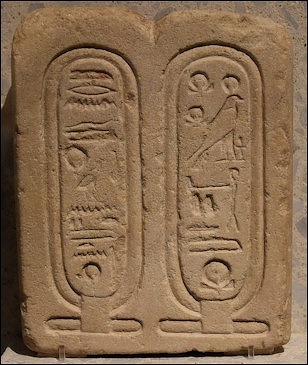
Aten cartouches
Mark Millmore wrote in discoveringegypt.com: “At the beginning of his reign, the young pharaoh, Amenhotep IV, still worshiped the old gods, especially Amun of Thebes and the sun god, Re-Harakhte. However, within a few years there were changes. He abandoned work on a temple dedicated to Re-Harakhte and began to build a new temple to worship the sun god Aten. In the fifth year of his reign, the king changed his name from Amenhotep (“Amun is Pleased”) to Akhenaten, or “Servant of the Aten” thus formally declaring his new religion. He moved his capital from Thebes more than 320 kilometers (200 miles) to north to Amarna on a desert bay on the east side of the Nile River. Here he began to build a new city, which he called Akhetaten, “Horizon of Aten.” [Source: Mark Millmore, discoveringegypt.com discoveringegypt.com ^^^]
Jacquelyn Williamson of George Mason University wrote: “On a stela from Karnak Temple Akhenaten announced that all deities but the Aten had “ceased” to exist. In year 5 he began to attack inscriptions and images of other gods, targeting Amun, Mut, and Khonsu in particular. However, sloppy and uneven destruction indicates that Akhenaten’s semi-literate demolition crews often chiseled out words that were only visually similar to the names of the gods they sought to destroy, so the demolition process was not a highly organized endeavor. In addition to attacking their images, the king taxed the temples of other gods, redirecting their revenue to the Aten’s establishments. As far as can be determined, this activity against other gods was predominant in the earlier years of the king’s reign. [Source: Jacquelyn Williamson, George Mason University, UCLA Encyclopedia of Egyptology, 2015, escholarship.org ]
Dr Kate Spence of Cambridge University wrote for the BBC: “The Egyptians had traditionally worshipped a whole pantheon of gods who were represented in human or animal form or as animal-headed humans. Some gods were specific to particular towns or places; others had broader appeal. From early periods solar gods such as Re had played an important role in Egyptian state religion because the distant but universal power of the sun fitted well with prevailing ideas of the supreme power of the king both within Egypt and beyond its borders. |::|
“In the New Kingdom (1550–1070 B.C.), solar gods again became prominent, among them the Aten, the visible sun-disk which can be seen traversing the sky each day. Akhenaten raised the Aten to the position of 'sole god', represented as a disk with rays of light terminating in hands which reach out to the royal family, sometimes offering the hieroglyphic sign for life. Akhenaten and his family are frequently shown worshipping the Aten or simply indulging in everyday activities beneath the disk. Everywhere the close ties between the king and god are stressed through art and text. The king forms the link between the god and ordinary people whose supposed focus of worship seems to have been Akhenaten and the royal family rather than the Aten itself.” [Source: Dr Kate Spence, BBC, February 17, 2011 |::|]
Akhenaten’s Religion
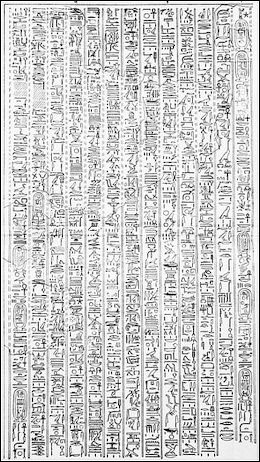
Great Hymn to Aten
Mark Millmore wrote in discoveringegypt.com: ““The religion of the Aten is not completely understood today. We do know that Akhenaten and his wife Nefertiti worshipped only the sun god, and the names of other gods and goddesses were removed from view. The funerary religion of Osiris was dropped, and Akhenaten became the source of blessings for people after death. The Aten was never shown in human or animal form, but represented as the sun disk with extended rays ending in hands. Aten was the life-giving and life-sustaining power of the sun. Unlike the old gods, he had no carved image hidden in a dark room deep within a temple, but was worshiped out in the light of day.” [Source: Mark Millmore, discoveringegypt.com discoveringegypt.com ^^^]
Dr Kate Spence of Cambridge University wrote for the BBC: “Akhenaten's religion is probably not strictly speaking monotheistic, although only the Aten is actually worshipped and provided with temples. Other gods still existed and are mentioned in inscriptions although these tend to be other solar gods or personifications of abstract concepts; even the names of the Aten, which are written in cartouches like king's names, consist of a theological statement describing the Aten in terms of other gods. The majority of traditional gods were not tolerated, however, and teams of workmen were sent around the temples of Egypt where they chiselled out the names and images of these gods wherever they occurred. A number of hymns to the Aten were composed during Akhenaten's reign and these provide a glimpse of what James Allen has described as the 'natural philosophy' of Akhenaten's religion. The wonders of the natural world are described to extol the universal power of the sun; all creatures rejoice when the sun rises and nasty things come out at night when the sun is not present.” [Source: Dr Kate Spence, BBC, February 17, 2011]
Jacquelyn Williamson of George Mason University wrote: “The religion of Atenism departed in many ways from traditional Egyptian beliefs. Akhenaten claimed that he was the Aten’s son and only prophet. Atenism centered on a visible deity responsible for all of creation, a deity that re-created itself daily. But the Aten was spiritually inaccessible and remote; most of humankind depended on the king’s mediation to approach the Aten. The visibility of the Aten in the sky and its universal life-giving properties contrasted with its spiritual remoteness. [Source: Jacquelyn Williamson, George Mason University, UCLA Encyclopedia of Egyptology, 2015, escholarship.org ]
“Because of the Aten’s visibility and concrete gifts to the earth, the cult of the Aten emphasized worshipping the visible and the real instead of the more abstract notions of the Amun cult. Although some suggest that Atenism was the first true “monotheist” religion in the ancient world, this is a misnomer. Many Amarna residents maintained beliefs in traditional household gods, such as Taweret and Bes. It is also impossible to prove that many embraced Atenism outside the royal family and the inner court. Atenism and Akhenaten’s changes may have been a centralized phenomenon that few in Egypt experienced directly.”
Discontent with Akhenaten's Monotheism
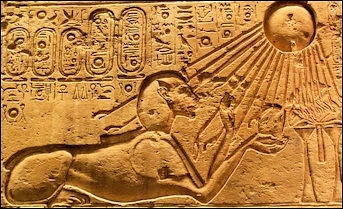
Akhenaten as a sphinx
But this religious and artistic renaissance was short lived; Akhenaten made himself unpopular by closing the old temples, and his lack of enthusiasm for the practical duties of kingship was detrimental to Egypt’s Imperial interests. Surviving documents show that Akhenaten paid little attention to the army and navy, foreign trade began to fall off, and internal taxes began to disappear into the pockets of local officials. [Source: Mark Millmore, discoveringegypt.com discoveringegypt.com ^^^]
“Letters to the king discovered in the ruins of Tell el-Amarna, known as the Amarna Letters, show the discontent of the army commanders and high commissioners in Palestine and Syria. The local princes, who had been loyal to Egypt, no longer saw any advantage in trading with Egypt. The Hittites from the north began to make gains and this led to a general disintegration of the empire. Eventually, dissatisfied priests and civil officials combined with the army to discredit the new religion. There is some evidence that at the urging of Tiy, the queen mother, Akhenaten made compromises to placate the different factions growing within Egyptian society. He also became estranged from Nefertiti.” ^^^
Move to Amarna
After formally declaring his new religion, Akhenaten moved his capital from Thebes more than 320 kilometers (200 miles) to north to Amarna in a desert area on the east side of the Nile River. Jacquelyn Williamson of George Mason University wrote: “ In year 5 on the 13th day of the 4th month of the season of “peret”, the king announced his intention to move the court to the city he named “Akhetaten” or “The Horizon of the Aten” at Tell el-Amarna in Middle Egypt. Sixteen boundary markers, or stelae, recorded the foundation of the site and Akhenaten’s building plans. According to Akhenaten, the Aten itself dictated this move because it wanted its cult relocated to virgin territory. However, politics may have been behind the relocation, as the elite Theban population may have started resisting Akhenaten’s changes. This contention is supported by a speech recorded on Boundary Stelae K, M, and X, where Akhenaten denounces what appear to be elite-generated aspersions on his kingship. [Source: Jacquelyn Williamson, George Mason University, UCLA Encyclopedia of Egyptology, 2015, escholarship.org ]
Dr Kate Spence of Cambridge University wrote for the BBC:“Akhenaten decided that the worship of the Aten required a location uncontaminated by the cults of traditional gods and to this end chose a site in Middle Egypt for a new capital city which he called Akhetaten, 'Horizon of the Aten'. It is a desert site surrounded on three sides by cliffs and to the west by the Nile and is known today as el-Amarna. In the cliffs around the boundaries of the city the king left a series of monumental inscriptions in which he outlined his reasons for the move and his architectural intentions for the city in the form of lists of buildings. [Source: Dr Kate Spence, BBC, February 17, 2011 |::|]
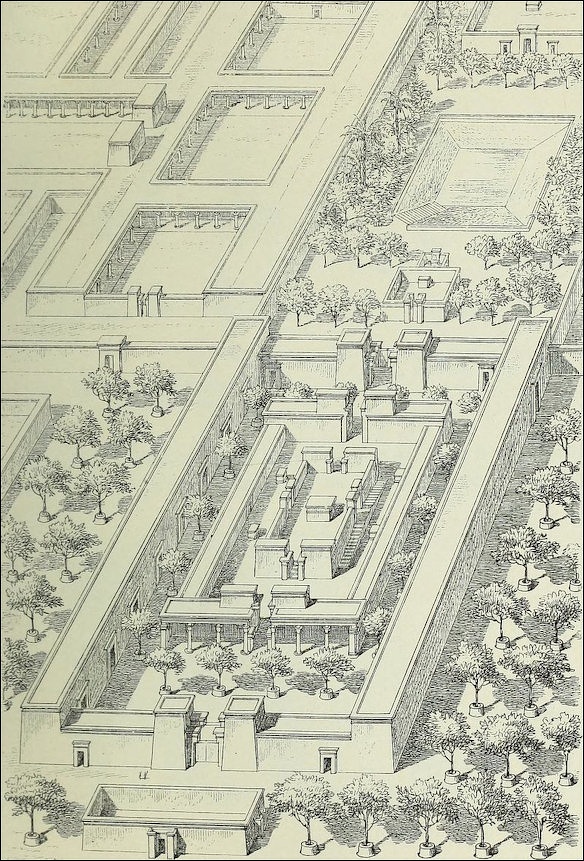
“To the east of the city is a valley leading into the desert in which the king began excavating tombs for the royal family. On the plain near the river massive temples to the Aten were constructed: these were open to the sky and the rays of the sun and were probably influenced by the design of much earlier solar temples dedicated to the cult of Re. Other sites of religious importance are located on the edges of the desert plain. There were also at least four palaces in the city which vary considerably in form, plus all the administrative facilities, storage and workshops necessary to support the royal family, court and the temple cults. |::|
Legacy of Akhenaten’s Monotheism
Akhenaten's religious ideas did not survive his death. His ideas were abandoned in part because of the economic collapse that ensued at the end of his reign. To restore the morale of the nation, Akhenaten's successor, Tutankhamen, appeased the offended gods whose resentment would have blighted all human enterprise. Temples were cleaned and repaired, new images made, priests appointed, and endowments restored. Akhenaten's new city was abandoned to the desert sands. [Source: Helen Chapin Metz, ed. Egypt: A Country Study, Library of Congress, 1990]
Dr Kate Spence of Cambridge University wrote for the BBC: “Akhenaten died in his seventeenth year on the throne and his reforms did not survive for long in his absence. His co-regent Smenkhkare, about whom we know virtually nothing, appears not to have remained in power for long after Akhenaten's death. The throne passed to a child, Tutankhamun (originally Tutankhaten) who was probably the son of Akhenaten and Kiya. The regents administering the country on behalf of the child soon abandoned the city of Akhetaten and the worship of the Aten and returned to Egypt's traditional gods and religious centres. The temples and cults of the gods were restored and people shut up their houses and returned to the old capitals at Thebes and Memphis. [Source: Dr Kate Spence, BBC, February 17, 2011 |::|]
“Over time, the process of restoration of traditional cults turned to whole-scale obliteration of all things associated with Akhenaten. His image and names were removed from monuments. His temples were dismantled and the stone reused in the foundations of other more orthodox royal building projects. The city of Akhetaten gradually crumbled back into the desert. His name and those of his immediate successors were omitted from official king-lists so that they remained virtually unknown until the archaeological discoveries at Akhetaten and in the tomb of Tutankhamun made these kings amongst the most famous of all rulers of ancient Egypt. |::|
Image Sources: Wikimedia Commons, The Louvre, The British Museum, The Egyptian Museum in Cairo
Text Sources: UCLA Encyclopedia of Egyptology, escholarship.org ; Internet Ancient History Sourcebook: Egypt sourcebooks.fordham.edu ; Tour Egypt, Minnesota State University, Mankato, ethanholman.com; Mark Millmore, discoveringegypt.com discoveringegypt.com; Metropolitan Museum of Art, National Geographic, Smithsonian magazine, New York Times, Washington Post, Los Angeles Times, Discover magazine, Times of London, Natural History magazine, Archaeology magazine, The New Yorker, BBC, Encyclopædia Britannica, Time, Newsweek, Wikipedia, Reuters, Associated Press, The Guardian, AFP, Lonely Planet Guides, “World Religions” edited by Geoffrey Parrinder (Facts on File Publications, New York); “History of Warfare” by John Keegan (Vintage Books); “History of Art” by H.W. Janson Prentice Hall, Englewood Cliffs, N.J.), Compton’s Encyclopedia and various books and other publications.
Last updated July 2024
